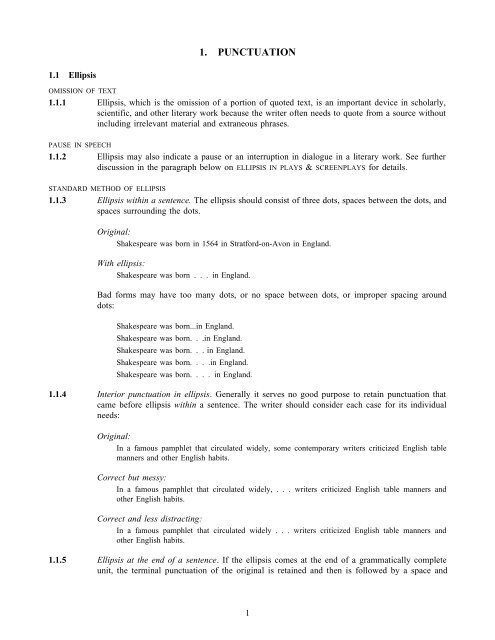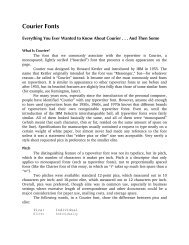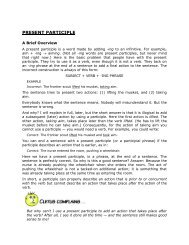Ellipsis - Roland Stroud
Ellipsis - Roland Stroud
Ellipsis - Roland Stroud
You also want an ePaper? Increase the reach of your titles
YUMPU automatically turns print PDFs into web optimized ePapers that Google loves.
1. PUNCTUATION<br />
1.1 <strong>Ellipsis</strong><br />
OMISSION OF TEXT<br />
1.1.1 <strong>Ellipsis</strong>, which is the omission of a portion of quoted text, is an important device in scholarly,<br />
scientific, and other literary work because the writer often needs to quote from a source without<br />
including irrelevant material and extraneous phrases.<br />
PAUSE IN SPEECH<br />
1.1.2 <strong>Ellipsis</strong> may also indicate a pause or an interruption in dialogue in a literary work. See further<br />
discussion in the paragraph below on ELLIPSIS IN PLAYS & SCREENPLAYS for details.<br />
STANDARD METHOD OF ELLIPSIS<br />
1.1.3 <strong>Ellipsis</strong> within a sentence. The ellipsis should consist of three dots, spaces between the dots, and<br />
spaces surrounding the dots.<br />
Original:<br />
Shakespeare was born in 1564 in Stratford-on-Avon in England.<br />
With ellipsis:<br />
Shakespeare was born . . . in England.<br />
Bad forms may have too many dots, or no space between dots, or improper spacing around<br />
dots:<br />
Shakespeare was born...in England.<br />
Shakespeare was born. . .in England.<br />
Shakespeare was born. . . in England.<br />
Shakespeare was born. . . .in England.<br />
Shakespeare was born. . . . in England.<br />
1.1.4 Interior punctuation in ellipsis. Generally it serves no good purpose to retain punctuation that<br />
came before ellipsis within a sentence. The writer should consider each case for its individual<br />
needs:<br />
Original:<br />
In a famous pamphlet that circulated widely, some contemporary writers criticized English table<br />
manners and other English habits.<br />
Correct but messy:<br />
In a famous pamphlet that circulated widely, . . . writers criticized English table manners and<br />
other English habits.<br />
Correct and less distracting:<br />
In a famous pamphlet that circulated widely . . . writers criticized English table manners and<br />
other English habits.<br />
1.1.5 <strong>Ellipsis</strong> at the end of a sentence. If the ellipsis comes at the end of a grammatically complete<br />
unit, the terminal punctuation of the original is retained and then is followed by a space and<br />
1
three dots with spaces. (Terminal punctuation includes ‘.’, ‘?’, ‘!’, and sometimes ‘:’.) The<br />
following example demonstrates the various principles:<br />
Original:<br />
Shakespeare was born in 1564 in Stratford-on-Avon in England. As a young man, he went to<br />
London, maybe took some odd jobs here and there, and soon became a prominent actor and<br />
playwright. He was also a shareholder in the Globe theater, where his plays were performed. Don’t<br />
you think those are good accomplishments for a small-town boy?<br />
With ellipsis:<br />
Shakespeare was born . . . in Stratford-on-Avon in England. As a young man, he went to<br />
London . . . and soon became a prominent actor and playwright. He was also a shareholder in the<br />
Globe theater. . . . Don’t you think those are good accomplishments? . . .<br />
A SIMPLER METHOD OF ELLIPSIS<br />
1.1.6 A more sensible approach is to use three dots for ellipsis in all instances to connect text to text,<br />
with spaces separating the dots from each other and the surrounding text. The Chicago Manual<br />
of Style (14th edition, 1994) prefers the standard method outlined above but will allow this<br />
simpler method, provided that the author uses it consistently. Termination of the quotation still<br />
requires four dots (or a question mark or exclamation point, followed by three dots):<br />
Shakespeare was born . . . in Stratford-on-Avon in England. As a young man, he went to<br />
London . . . and soon became a prominent actor and playwright. He was also a shareholder in the<br />
Globe theater . . . Don’t you think those are good accomplishments? . . .<br />
CAPITALIZATION AFTER ELLIPSIS<br />
1.1.7 The first word after an ellipsis, if it is not already the beginning of a sentence, may be left in<br />
lower case, introduced with a bracketed capital, or simply capitalized. Conservative authorities<br />
pedantically require the use of a bracketed capital, in all scholarly works, to show that the word<br />
did not originally begin a sentence. The following examples illustrate capitalization and the<br />
optional use of three or four dots:<br />
Scholarly:<br />
Shakespeare was born in 1564. . . . [H]e went to London, maybe took some odd jobs here and<br />
there, and soon became a prominent actor. . . .<br />
Shakespeare was born in 1564 . . . [H]e went to London, maybe took some odd jobs here and<br />
there, and soon became a prominent actor. . . .<br />
Acceptable:<br />
Shakespeare was born in 1564. . . . he went to London, maybe took some odd jobs here and<br />
there, and soon became a prominent actor. . . .<br />
Shakespeare was born in 1564. . . . He went to London, maybe took some odd jobs here and<br />
there, and soon became a prominent actor. . . .<br />
Shakespeare was born in 1564 . . . He went to London, maybe took some odd jobs here and there,<br />
and soon became a prominent actor. . . .<br />
2
CONSISTENCY<br />
1.1.8 It is proper style to use the same method for representing ellipsis throughout the entirety of a<br />
work. It is not unusual to find lackadaisical writing with improperly placed groups of three or<br />
four dots, with no consistency whatever.<br />
SPACING OF DOTS<br />
1.1.9 The spacing of the dots is important. Although it is common for writers to place the dots<br />
together with no spaces between them, such practice is generally unacceptable. As a rule, there<br />
should always be a space between any two dots, as well as between a dot and any other<br />
adjacent mark of punctuation. (See ELLIPSIS IN PLAYS & SCREENPLAYS, below, for the exception<br />
when using a monospaced font.)<br />
ELLIPSIS IN PLAYS & SCREENPLAYS<br />
1.1.10 Exception to the rule. Dialogue lines in screenplays are very short (3-3½ inches). The standard<br />
font is monospaced Courier. <strong>Ellipsis</strong> dots with spaces gobble up a good deal of line length in a<br />
monospaced font that gives only ten characters per inch. Over a script of 115 pages, this lost<br />
space can add up. Moreover, word wrap in screenwriting software is not as sophisticated and<br />
customizable, at present, as in word processors. Dots may become separated at the end of a line<br />
when the line wraps. For these reasons it is better to omit the spaces between the dots.<br />
Obviously, this is an exception to the principles laboriously outlined above.<br />
1.1.11 The current practice of handling ellipsis in screenplays appears to follow the whim of each<br />
writer. Nonetheless, it is possible to offer some guidelines which are a rational application and<br />
modification of the general principles already presented.<br />
1.1.12 Four-dot method. Use of four-dot ellipsis (or ‘?’ or ‘!’, plus three dots) at the end of a<br />
grammatically complete unit, and three dots to link within the same sentence, is the most logical<br />
method. In the next example the ‘. . . .’ after today signals an end of the sentence and a pause<br />
or sudden change. The ‘? . . .’ after wrong is likewise the end of a sentence and the start of a<br />
break. The first dot (or ‘?’ or ‘!’) is printed up close to the preceding word. The ‘. . .’ between<br />
just and tell connects two fragments and has spaces before and after the group, since Please,<br />
just is not a complete sentence.<br />
Excellent form:<br />
HANK<br />
You look strange today.... What’s<br />
wrong?... Please, just ... tell me.<br />
1.1.13 Three-dot method. Many writers cannot distinguish easily between text that is grammatically<br />
complete and text that is fragmentary. Fortunately, three-dot ellipsis, which is an acceptable<br />
method, keeps everything simple. As long as the dot group is preceded and followed by a space,<br />
three dots can connect a sentence to a sentence, a sentence to a fragment, or a fragment to a<br />
fragment. Although writers commonly use the three dots, they frequently fail to set the dot<br />
group off with spaces. It is noteworthy that formatting properly by adding spaces can actually<br />
save line space sometimes and sometimes result in fewer lines, because the spaces before and<br />
after the dot group allow better word wrap. The following examples illustrate this.<br />
3
Good form:<br />
HANK<br />
You look strange today ... What’s<br />
wrong?... Please, just ... tell me.<br />
JIM<br />
Is this what you call ... friendly<br />
... or are you kidding?<br />
Poor form:<br />
HANK<br />
You look strange today...What’s<br />
wrong?...Please, just...tell me.<br />
JIM<br />
Is this what you<br />
call...friendly...or are you<br />
kidding?<br />
1.1.14 Dialogue that trails off. Sometimes a writer will use a series of dots at the very end of a speech<br />
to indicate that the words trail off or that a pause ensues. The speaker seems to have said all<br />
that he intends to at the moment. To convey this, the writer will preferably use the four-dot<br />
form (or ‘?’ or ‘!’, plus three dots) if the statement is grammatically complete. However, the<br />
three-dot form is an acceptable alternative in this situation. In the event that the statement is not<br />
grammatically complete, the three-dot ellipsis is the proper form:<br />
Preferable:<br />
Acceptable:<br />
I guess this is my friend....<br />
With all his money, still ...<br />
Is this my friend?...<br />
You’ve got to be kidding!...<br />
I guess this is my friend ...<br />
1.1.15 Interrupted speech. If a speech, instead of coming to a natural pause or stop, is interrupted, then<br />
three dots (not four) mark the break, regardless of grammatical completeness. If there is a later<br />
continuation, three dots, set off from the text, can optionally introduce the continuation.<br />
Good form:<br />
HANK<br />
I saw her just yesterday ...<br />
JIM<br />
(interrupting)<br />
Look out for that car!<br />
4
HANK<br />
... Yeah, I see it.... Anyway, as I<br />
was saying, she told me the whole<br />
story.<br />
1.1.16 Putting spaces between ellipsis dots will waste space in short lines composed in a monospaced<br />
font, even though the method is technically correct.<br />
Correct but inefficient in screenplay dialogue:<br />
HANK<br />
Is this what you call . . .<br />
friendly?<br />
Much better:<br />
HANK<br />
Is this what you call ... friendly?<br />
Miscellaneous sloppy methods which one may encounter include:<br />
Is that what you call.... friendly?<br />
Is that what you call... friendly?<br />
Is that what you call....friendly?<br />
This is my friend....His name is<br />
Mike.<br />
I guess this is my friend...<br />
That’s silly. ...Wouldn’t you<br />
agree?<br />
The last example appeared, with completely different words, in the magazine Creative<br />
Screenwriter in an excerpt from a screenplay. Presumably the author, who is a prominent<br />
screenwriter in Hollywood, was trying to convey a directorial hint that the character pauses<br />
briefly at the end of the sentence, after silly, and then adds an afterthought. But the method<br />
offers no advantage over either of the correct methods:<br />
That’s silly.... Wouldn’t you<br />
agree?<br />
That’s silly ... Wouldn’t you<br />
agree?<br />
5
ELLIPSIS WITH COMPUTERS<br />
1.1.17 Another problem that arises in spacing the dots, when using computers (and who does not<br />
today?), is that spaced dots may unexpectedly “wrap” at the end of a line, breaking between two<br />
of the dots:<br />
The man picked up his change and counted it. “Say, buddy,” he asked the waiter, “Did . .<br />
. you make a mistake?”<br />
This problem is avoidable with most high-end word processors, which allow the writer to enter<br />
a special space that will not break. In WordPerfect® it is Ctrl-Space. In Microsoft® Word97 it<br />
is Ctrl-Shift-Space. In WordPerfect® (DOS version) it is Home-Space. It is permissible to have<br />
‘. . .’ at the end or start of a line if it happens to fall there.<br />
Computers can produce (in some font sets, anyway) a special three-dot character ‘…’ (no<br />
spaces) when the keyboard operator strikes a combination of keys:<br />
• ANSI character number 133: on numeric keypad with Alt-0133<br />
• In Microsoft® Word97: Alt-Shift-Period<br />
• In WordPerfect®: Ctrl-W 4,56<br />
However, this character is not appropriate for representing ellipsis, since it consists of three dots<br />
with no spaces and in some fonts produces three exceedingly tiny dots.<br />
Microsoft® Word97, under Tools/AutoCorrect, has a list of replacement “corrections” that the<br />
program makes when certain key combinations are struck. Typing three dots in succession (no<br />
spaces) will trigger an automatic replacement by the tiny ellipsis character. Consequently, users<br />
should consider deleting this “correction” from AutoCorrect. (It can be restored at any time by<br />
re-entering three dots in AutoCorrect and inserting the ellipsis symbol from the Insert/Symbol<br />
menu.)<br />
OTHER CONSIDERATIONS<br />
1.1.18 <strong>Ellipsis</strong> in two successive paragraphs. A paragraph may end with ellipsis and the next<br />
paragraph begin with ellipsis. In that case, the last sentence of the first paragraph follows the<br />
principles discussed above, and the next paragraph is introduced by the usual first-line<br />
indentation, followed by a group of three dots with spaces and a space after the group.<br />
1.1.19 <strong>Ellipsis</strong> in poetry. Sometimes it is convenient to leave out one or more lines of a poem that is<br />
being quoted. Omission is signaled by placing a line of spaced dots across the entire line length.<br />
The line of dots can stand for any number of lines in succession — e.g., deletion of lines 5, 6,<br />
7 would require just one line of dots. Deletion of line 14 would require another line of dots.<br />
6




